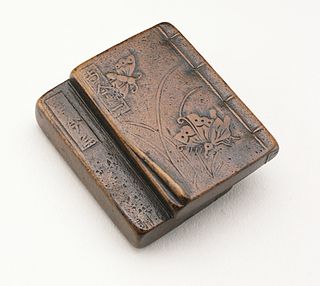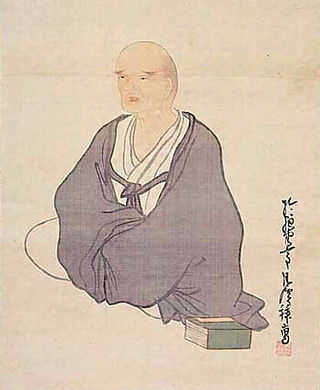
Haiku is a type of short form poetry that originated in Japan. Traditional Japanese haiku consist of three phrases composed of 17 phonetic units in a 5, 7, 5 pattern; that include a kireji, or "cutting word"; and a kigo, or seasonal reference. However, haiku by classical Japanese poets, such as Matsuo Bashō, also deviate from the 17-on pattern and sometimes do not contain a kireji. Similar poems that do not adhere to these rules are generally classified as senryū.

Matsuo Bashō; born Matsuo Kinsaku, later known as Matsuo Chūemon Munefusa was the most famous Japanese poet of the Edo period. During his lifetime, Bashō was recognized for his works in the collaborative haikai no renga form; today, after centuries of commentary, he is recognized as the greatest master of haiku. He is also well known for his travel essays beginning with Records of a Weather-Exposed Skeleton (1684), written after his journey west to Kyoto and Nara. Matsuo Bashō's poetry is internationally renowned, and, in Japan, many of his poems are reproduced on monuments and traditional sites. Although Bashō is famous in the West for his hokku, he himself believed his best work lay in leading and participating in renku. As he himself said, "Many of my followers can write hokku as well as I can. Where I show who I really am is in linking haikai verses."
Renga is a genre of Japanese collaborative poetry in which alternating stanzas, or ku (句), of 5-7-5 and 7-7 mora per line are linked in succession by multiple poets. Known as tsukuba no michi after the famous Tsukuba Mountain in the Kantō region, the form of poetry is said to have originated in a two-verse poetry exchange by Yamato Takeru and later gave birth to the genres haikai (俳諧) and haiku (俳句).

A kigo is a word or phrase associated with a particular season, used in traditional forms of Japanese poetry. Kigo are used in the collaborative linked-verse forms renga and renku, as well as in haiku, to indicate the season referred to in the stanza. They are valuable in providing economy of expression.

Japanese poetry is poetry typical of Japan, or written, spoken, or chanted in the Japanese language, which includes Old Japanese, Early Middle Japanese, Late Middle Japanese, and Modern Japanese, as well as poetry in Japan which was written in the Chinese language or ryūka from the Okinawa Islands: it is possible to make a more accurate distinction between Japanese poetry written in Japan or by Japanese people in other languages versus that written in the Japanese language by speaking of Japanese-language poetry. Much of the literary record of Japanese poetry begins when Japanese poets encountered Chinese poetry during the Tang dynasty. Under the influence of the Chinese poets of this era Japanese began to compose poetry in Chinese kanshi); and, as part of this tradition, poetry in Japan tended to be intimately associated with pictorial painting, partly because of the influence of Chinese arts, and the tradition of the use of ink and brush for both writing and drawing. It took several hundred years to digest the foreign impact and make it an integral part of Japanese culture and to merge this kanshi poetry into a Japanese language literary tradition, and then later to develop the diversity of unique poetic forms of native poetry, such as waka, haikai, and other more Japanese poetic specialties. For example, in the Tale of Genji both kanshi and waka are frequently mentioned. The history of Japanese poetry goes from an early semi-historical/mythological phase, through the early Old Japanese literature inclusions, just before the Nara period, the Nara period itself, the Heian period, the Kamakura period, and so on, up through the poetically important Edo period and modern times; however, the history of poetry often is different from socio-political history.

Yosa Buson or Yosa no Buson was a Japanese poet and painter of the Edo period. He lived from 1716 – January 17, 1784. Along with Matsuo Bashō and Kobayashi Issa, Buson is considered among the greatest poets of the Edo Period. He is also known for completing haiga as a style of art, working with haibun prose, and experimenting with a mixed Chinese-Japanese style of poetry.
Fukuda Chiyo-ni or Kaga no Chiyo was a Japanese poet of the Edo period and a Buddhist nun. She is widely regarded as one of the greatest poets of haiku. Some of Chiyo's most notable works include "The Morning Glory", "Putting up my hair", and "Again the women".

Haiga is a style of Japanese painting that incorporates the aesthetics of haikai. Haiga are typically painted by haiku poets (haijin), and often accompanied by a haiku poem. Like the poetic form it accompanied, haiga was based on simple, yet often profound, observations of the everyday world. Stephen Addiss points out that "since they are both created with the same brush and ink, adding an image to a haiku poem was ... a natural activity."
Renku, or haikai no renga, is a Japanese form of popular collaborative linked verse poetry. It is a development of the older Japanese poetic tradition of ushin renga, or orthodox collaborative linked verse. At renku gatherings participating poets take turns providing alternating verses of 17 and 14 morae. Initially haikai no renga distinguished itself through vulgarity and coarseness of wit, before growing into a legitimate artistic tradition, and eventually giving birth to the haiku form of Japanese poetry. The term renku gained currency after 1904, when Kyoshi Takahama started to use it.
Hokku is the opening stanza of a Japanese orthodox collaborative linked poem, renga, or of its later derivative, renku. From the time of Matsuo Bashō (1644–1694), the hokku began to appear as an independent poem, and was also incorporated in haibun. In the late 19th century, Masaoka Shiki (1867–1902) renamed the standalone hokku as "haiku", and the latter term is now generally applied retrospectively to all hokku appearing independently of renku or renga, irrespective of when they were written. The term hokku continues to be used in its original sense, as the opening verse of a linked poem.
Haikai may refer in both Japanese and English to haikai no renga (renku), a popular genre of Japanese linked verse, which developed in the sixteenth century out of the earlier aristocratic renga. It meant "vulgar" or "earthy", and often derived its effect from satire and puns, though "under the influence of [Matsuo] Bashō (1644–1694) the tone of haikai no renga became more serious". "Haikai" may also refer to other poetic forms that embrace the haikai aesthetic, including haiku and senryū, haiga, and haibun. However, haikai does not include orthodox renga or waka.
Nishiyama Sōin was a haikai-no-renga poet of the early Tokugawa period.
The Danrin school (談林派) is a school of haikai poetry founded by the poet Nishiyama Sōin. The name literally means 'talkative forest' – in other words a ‘Literary Forest’.
Nationality words link to articles with information on the nation's poetry or literature.

Takarai Kikaku also known as Enomoto Kikaku, was a Japanese haikai poet and among the most accomplished disciples of Matsuo Bashō. His father was an Edo doctor, but Kikaku chose to become a professional haikai poet rather than follow in his footsteps.
Nationality words link to articles concerning that nation's poetry or literature.
Miura Chora was a Japanese poet raised in Ise, in the Mie Prefecture of Shima Province on the island of Honshu, Japan. He traveled throughout the country composing poems and helped lead the Matsuo Bashō revival movement of the eighteenth century.
Sarumino is a 1691 anthology, considered the magnum opus of Bashō-school poetry. It contains four kasen renku as well as some 400 hokku, collected by Nozawa Bonchō and Mukai Kyorai under the supervision of Matsuo Bashō. Sarumino is one of the Seven Major Anthologies of Bashō, and, together with the 1690 anthology, Hisago, it is considered to display Bashō's mature style (Shōfū) at its peak. Bashō's influence on all four of the kasen in Sarumino was profound and when he sat with Bonchō, Okada Yasui and Kyorai at Yoshinaka Temple to write "Kirigirisu", he extolled them, "Let's squeeze the juice from our bones."
Hattori Ransetsu was an Edo samurai who became a haikai poet under the guidance of Matsuo Bashō.







